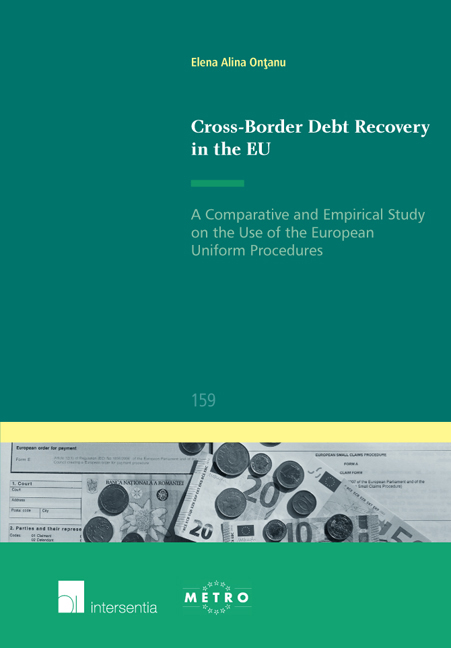 Cross-Border Debt Recovery in the EU
Cross-Border Debt Recovery in the EU Book contents
- Frontmatter
- Acknowledgements
- Contents
- Abbreviations
- Chapter 1 Introduction
- Chapter 2 A European Perspective on the EOP and the ESCP
- Chapter 3 England and Wales
- Chapter 4 France
- Chapter 5 Italy
- Chapter 6 Romania
- Chapter 7 Comparative Perspectives on the Functioning of the EOP and ESCP
- Chapter 8 Conclusions
- Samenvatting
- Annex
- Bibliography
- Table of Cases
- Curriculum Vitae
- Ius Commune Europaeum
Chapter 5 - Italy
Published online by Cambridge University Press: 11 October 2018
- Frontmatter
- Acknowledgements
- Contents
- Abbreviations
- Chapter 1 Introduction
- Chapter 2 A European Perspective on the EOP and the ESCP
- Chapter 3 England and Wales
- Chapter 4 France
- Chapter 5 Italy
- Chapter 6 Romania
- Chapter 7 Comparative Perspectives on the Functioning of the EOP and ESCP
- Chapter 8 Conclusions
- Samenvatting
- Annex
- Bibliography
- Table of Cases
- Curriculum Vitae
- Ius Commune Europaeum
Summary
Introduction
The Italian legal system is one of civil law. Judicial decisions do not have a binding authority in proceedings other than those in which they are rendered, which include decisions of the Supreme Court (Corte di cassazione). The Italian civil procedure rules are contained mainly in the 1940 Code of Civil Procedure (CPC). Some procedural rules are also contained in the Italian Constitution, the Civil Code (e.g. evidence provisions, enforcement), and special legal acts (e.g. processo telematico). The CPC has been the object of continuous reform and modification since the 1990s in an attempt to deal with the increasing crisis involving civil justice and a backlog of cases. The reforms of November 2014 proposed a series of measures aimed at improving the efficiency of civil proceedings and discouraging excessive litigation. This ongoing reform is partly a response to reforms already undertaken that have not succeeded in reducing the backlog and the duration of proceedings. The situation hampers access to justice, and is a serious drawback for economic activities. Furthermore, civil proceedings in Italy are subject to the law in force at the time that the claim is registered with the court. The increased number of civil rule amendments has led to different sets of provisions applying at the same time, which has added to the complexity of the proceedings.
This chapter discusses from which proceedings creditors may choose in order to seek recovery of their debts before Italian courts. Section 5.2 provides an overview of the national ordinary procedure and its characteristics. In addition to the ordinary procedure, which often proves very lengthy, the CPC offers alternative instruments for dealing with uncontested and small value claims. These are examined in Section 5.3 and compared to the European uniform procedures. Section 5.4 analyses the position of Italian stakeholders with regard to the EOP and the ESCP. Section 5.5 focuses on implementation of the European uniform procedures in the national procedural system and practice. Section 5.6 examines the domestic execution process and the enforcement of EOPs and ESCPs in Italy. Section 5.7 looks at the functioning of the EOP and the ESCP in practice on the basis of available statistics, published case law, and the results of the empirical research.
- Type
- Chapter
- Information
- Cross-Border Debt Recovery in the EUA Comparative and Empirical Study on the Use of the European Uniform Procedures, pp. 191 - 286Publisher: IntersentiaPrint publication year: 2017
